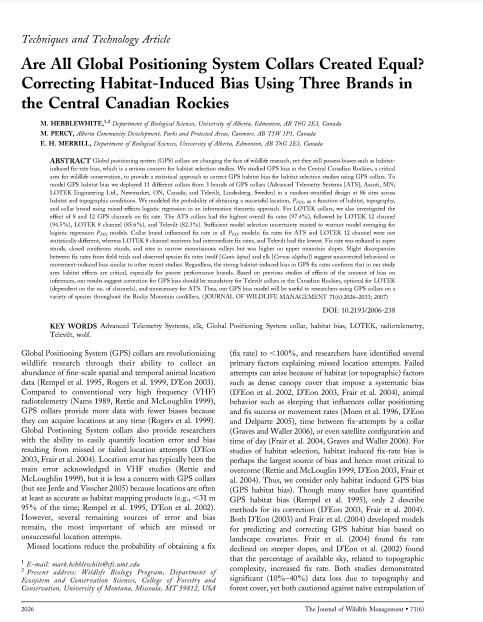Are all Global Positioning System Collars Created Equal? Correcting Habitat-Induced Bias Using Three Brands in the Central Canadian Rockies
Bosque Modelo:
Foothills
Temática:
Gestión forestal
Tipo de documento:
Artículo científico
Resumen
Global positioning system (GPS) collars are changing the face of wildlife research, yet they still possess biases such as habitatinduced frx-rate bias, which is a serious concern for habitat selection studies. We studied GPS bias in the Central Canadian Rockies, a critical area for wildlife conservation, to provide a statistical approach to correct GPS habitat bias for habitat selection studies using GPS collars. To model GPS habitat bias we deployed 11 different collars from 3 brands of GPS collars (Advanced Telemetry Systems [ATS], Asanti, MN; LOTEK Engineering Ltd., Newmarket, ON, Canada; and TelevUt, Lindesberg, Sweden) in a random-stratified design at 86 sites across habitat and topographic conditions. We modeled the probability of obtaining a successful location, PFIx^ a function of habitat, topography, and collar brand using mixed-effects logistic regression in an information theoretic approach. For LOTEK collars, we also investigated the effect of 8 and 12 GPS channels on fix rate. The ATS collars had the highest overall fix rates (97.4%), followed by LOTEK 12 channel (94.5%), LOTEK 8 channel (85.6%), and Televilt (82.3%). Sufficient model selection uncertainty existed to warrant model averaging for logistic regression P p ix models. Collar brand influenced fix rate in all P p ix models: fix rates for ATS and LOTEK 12 channel were not statistically different, whereas LOTEK 8 channel receivers had intermediate fix rates, and Televilt had the lowest. Fix rate was reduced in aspen stands, closed coniferous stands, and sites in narrow mountainous valleys but was higher on upper mountain slopes. Slight discrepancies between fix rates firom field trials and observed species fix rates (wolf \_Canis lupus\ and elk \_Cervus elaphusP) suggest uncorrected behavioral or movement-induced bias similar to other recent studies. Regardless, the strong habitat-induced bias in GPS fix rates confirms that in our study area habitat effects are critical, especially for poorer performance brands. Based on previous studies of effects of the amount of bias on inferences, our results suggest correction for GPS bias should be mandatory for Televilt collars in the Canadian Rockies, optional for LOTEK (dependent on the no. of channels), and unnecessary for ATS. Thus, our GPS bias model wiU be useful to researchers using GPS collars on a variety of species throughout the Rocky Mountain cordiUera
Información Bibliográfica
Autor:
Hebblewhite, M, M Percy and E Merrill.
Revista:
Journal of Wildlife Management
Año:
2007
N°:
6
País :
Canadá
Páginas:
2026 - 2033
Volumen:
71
Idioma:
Ingles
Palabras claves
Advanced Telemetry Systems, elk, Global Positioning System collar, habitat bias, LOTEK, radiotelemetry, Televilt, wolf





